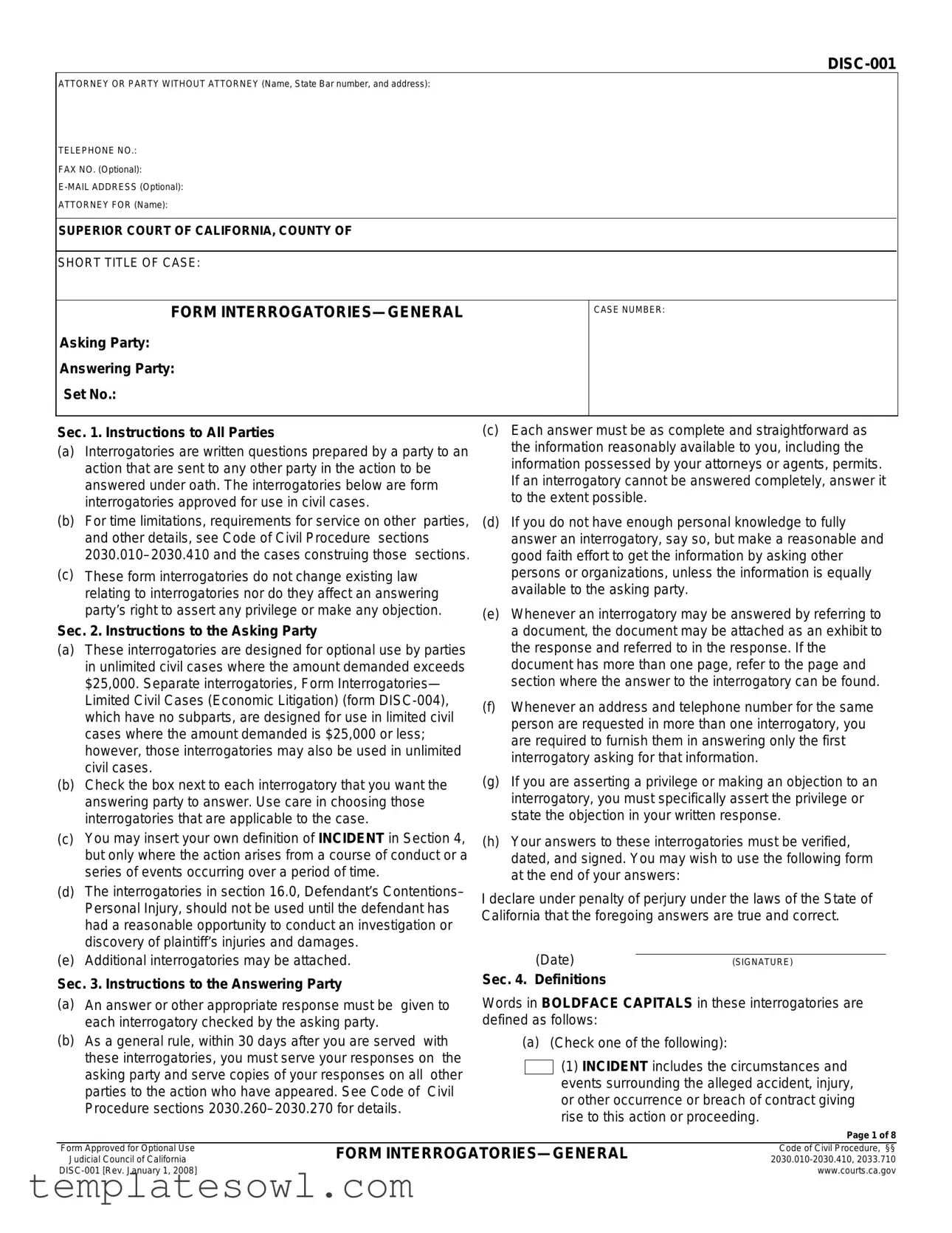 12.4 Do YOU OR ANYONE ACTING ON YOUR BEHALF know of any photographs, films, or videotapes depicting any place, object, or individual concerning the INCIDENT or plaintiff's injuries? If so, state:
12.4 Do YOU OR ANYONE ACTING ON YOUR BEHALF know of any photographs, films, or videotapes depicting any place, object, or individual concerning the INCIDENT or plaintiff's injuries? If so, state:
(a)the number of photographs or feet of film or videotape;
(b)the places, objects, or persons photographed, filmed, or videotaped;
(c)the date the photographs, films, or videotapes were taken;
(d)the name, ADDRESS, and telephone number of the individual taking the photographs, films, or videotapes; and
(e)the name, ADDRESS, and telephone number of each PERSON who has the original or a copy of the photographs, films, or videotapes.
 12.5 Do YOU OR ANYONE ACTING ON YOUR BEHALF know of any diagram, reproduction, or model of any place or thing (except for items developed by expert witnesses covered by Code of Civil Procedure sections 2034.210– 2034.310) concerning the INCIDENT? If so, for each item state:
12.5 Do YOU OR ANYONE ACTING ON YOUR BEHALF know of any diagram, reproduction, or model of any place or thing (except for items developed by expert witnesses covered by Code of Civil Procedure sections 2034.210– 2034.310) concerning the INCIDENT? If so, for each item state:
(a)the type (i.e., diagram, reproduction, or model);
(b)the subject matter; and
(c)the name, ADDRESS, and telephone number of each PERSON who has it.
 12.6 Was a report made by any PERSON concerning the INCIDENT? If so, state:
12.6 Was a report made by any PERSON concerning the INCIDENT? If so, state:
(a)the name, title, identification number, and employer of the PERSON who made the report;
(b)the date and type of report made;
(c)the name, ADDRESS, and telephone number of the PERSON for whom the report was made; and
(d)the name, ADDRESS, and telephone number of each PERSON who has the original or a copy of the report.
 12.7 Have YOU OR ANYONE ACTING ON YOUR BEHALF inspected the scene of the INCIDENT? If so, for each inspection state:
12.7 Have YOU OR ANYONE ACTING ON YOUR BEHALF inspected the scene of the INCIDENT? If so, for each inspection state:
(a)the name, ADDRESS, and telephone number of the individual making the inspection (except for expert witnesses covered by Code of Civil Procedure sections 2034.210–2034.310); and
(b)the date of the inspection.
13.0Investigation—Surveillance
13.1 Have YOU OR ANYONE ACTING ON YOUR BEHALF conducted surveillance of any individual involved in the INCIDENT or any party to this action? If so, for each surveillance state:
(a)the name, ADDRESS, and telephone number of the individual or party;
(b)the time, date, and place of the surveillance;
(c)the name, ADDRESS, and telephone number of the individual who conducted the surveillance; and
(d)the name, ADDRESS, and telephone number of each PERSON who has the original or a copy of any surveillance photograph, film, or videotape.
DISC-001
 13.2 Has a written report been prepared on the surveillance? If so, for each written report state:
13.2 Has a written report been prepared on the surveillance? If so, for each written report state:
(a)the title;
(b)the date;
(c)the name, ADDRESS, and telephone number of the individual who prepared the report; and
(d)the name, ADDRESS, and telephone number of each PERSON who has the original or a copy.
14.0 Statutory or Regulatory Violations
14.1 Do YOU OR ANYONE ACTING ON YOUR BEHALF contend that any PERSON involved in the INCIDENT violated any statute, ordinance, or regulation and that the violation was a legal (proximate) cause of the INCIDENT? If so, identify the name, ADDRESS, and telephone number of each PERSON and the statute, ordinance, or regulation that was violated.
14.2 Was any PERSON cited or charged with a violation of any statute, ordinance, or regulation as a result of this INCIDENT? If so, for each PERSON state:
(a)the name, ADDRESS, and telephone number of the
PERSON;
(b)the statute, ordinance, or regulation allegedly violated;
(c)whether the PERSON entered a plea in response to the citation or charge and, if so, the plea entered; and
(d)the name and ADDRESS of the court or administrative agency, names of the parties, and case number.
15.0 Denials and Special or Affirmative Defenses
15.1 Identify each denial of a material allegation and each special or affirmative defense in your pleadings and for each:
(a)state all facts upon which you base the denial or special or affirmative defense;
(b)state the names, ADDRESSES, and telephone numbers of all PERSONS who have knowledge of those facts; and
(c)identify all DOCUMENTS and other tangible things that support your denial or special or affirmative defense, and state the name, ADDRESS, and telephone number of the PERSON who has each
DOCUMENT.
16.0Defendant’s Contentions—Personal Injury
16.1 Do you contend that any PERSON, other than you or plaintiff, contributed to the occurrence of the INCIDENT or the injuries or damages claimed by plaintiff? If so, for each
PERSON:
(a)state the name, ADDRESS, and telephone number of the PERSON;
(b)state all facts upon which you base your contention;
(c)state the names, ADDRESSES, and telephone numbers of all PERSONS who have knowledge of the facts; and
(d)identify all DOCUMENTS and other tangible things that support your contention and state the name, ADDRESS, and telephone number of the PERSON
who has each DOCUMENT or thing.
16.2 Do you contend that plaintiff was not injured in the INCIDENT? If so:
(a)state all facts upon which you base your contention;
(b)state the names, ADDRESSES, and telephone numbers of all PERSONS who have knowledge of the facts; and
(c)identify all DOCUMENTS and other tangible things that support your contention and state the name, ADDRESS, and telephone number of the PERSON who has each DOCUMENT or thing.



 (1)
(1) 
 1.1 State the name,
1.1 State the name, 
 2.12 At the time of the INCIDENT
2.12 At the time of the INCIDENT 
 6.3 Do you still have any complaints that you attribute to the
6.3 Do you still have any complaints that you attribute to the 
 6.4 Did you receive any consultation or examination (except from expert witnesses covered by Code of Civil Procedure sections
6.4 Did you receive any consultation or examination (except from expert witnesses covered by Code of Civil Procedure sections  6.6 Are there any other medical services necessitated by the injuries that you attribute to the INCIDENT
6.6 Are there any other medical services necessitated by the injuries that you attribute to the INCIDENT 



 12.6 Was a report made by any
12.6 Was a report made by any 
 13.2 Has a written report been prepared on the surveillance? If so, for each written report state:
13.2 Has a written report been prepared on the surveillance? If so, for each written report state:
